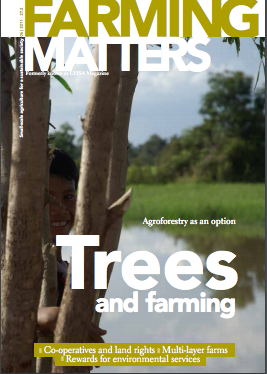Dov Pasternak argues for more tree cover in the semi-arid tropics.
Farming Matters | 27.2 | June 2011
About seventy percent of sub Sahara Africa is in the semiarid tropics. Farmers there are among the poorest in the world, as low soil fertility and erratic rains lead to poor yields. Trees are significantly more resilient to such conditions than the annual crops that most farmers grow. Why is this not fully exploited?
One way could be to find trees whose products have a similar or higher value than that of annual crops. This is actually the situation in the Mediterranean, where farmers get a significant income from olives and figs. The domesticated Ziziphus mauritiana or Pomme du Sahel might be one such species. Its fruits are 10 to 20 times bigger than the fruit of the wild variety and there is a local market for it. Shea nut (or karité) is another option. This is a common tree in the region, and the oil in the kernels is very valuable. In both cases, grafting wild trees with superior strains can increase the yield and quality.
Agro-pastoralism is the dominant production system in the region, but livestock consume all the crop residues and the resulting bare soil becomes susceptible to erosion. As seen in southern Niger, agroforestry can help conserve and revitalise the soil. To date it has had a strong impact: farmers adopting it have seen their crop yields and incomes rise by almost 50 percent. Faidherbia albida – locally called gao – is a nitrogenfixing tree and an ideal species for this purpose. It sheds its leaves during the rainy season and does not compete with annual crops. Reports from Zambia show that the soil’s organic matter and nitrogen content increases under gao trees, and the yield of maize can double or even triple. Some governments now promote agroforestry systems based on gao, as it is an excellent solution to the problems of land degradation and the sharp increase in the prize of fertilizers.
The technical solutions are known. I think that the problem is that development agencies and governments do not understand the ecological context in the semi-arid tropics very well. Their rural development strategies are often based on experiences in temperate or tropical regions, and thus encourage high-yielding varieties of rainfed crops, intensive application of fertilizers, and market integration. They address only the symptoms and not the problems. Agroforestry offers a solution with ecological and social benefits. It provides an ecological framework in which cash crops thrive. Isn’t it the obvious alternative to the degradation and poverty we see in the semi-arid regions?
Text: Dov Pasternak
Dov Pasternak was a researcher in agroforestry at the Ben Gurion University in Israel and at ICRISAT, West and Central Africa. He has been developing agroforestry systems for the arid and semi-arid regions over the last 35 years. His e-mail is dovp@bgu.ac.il.

